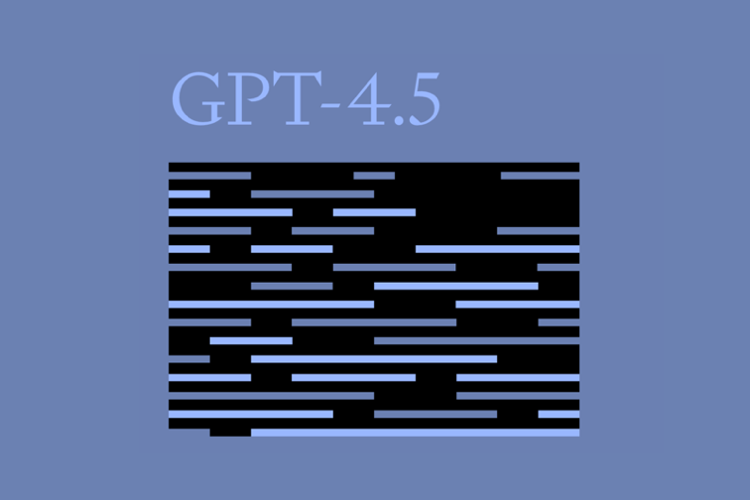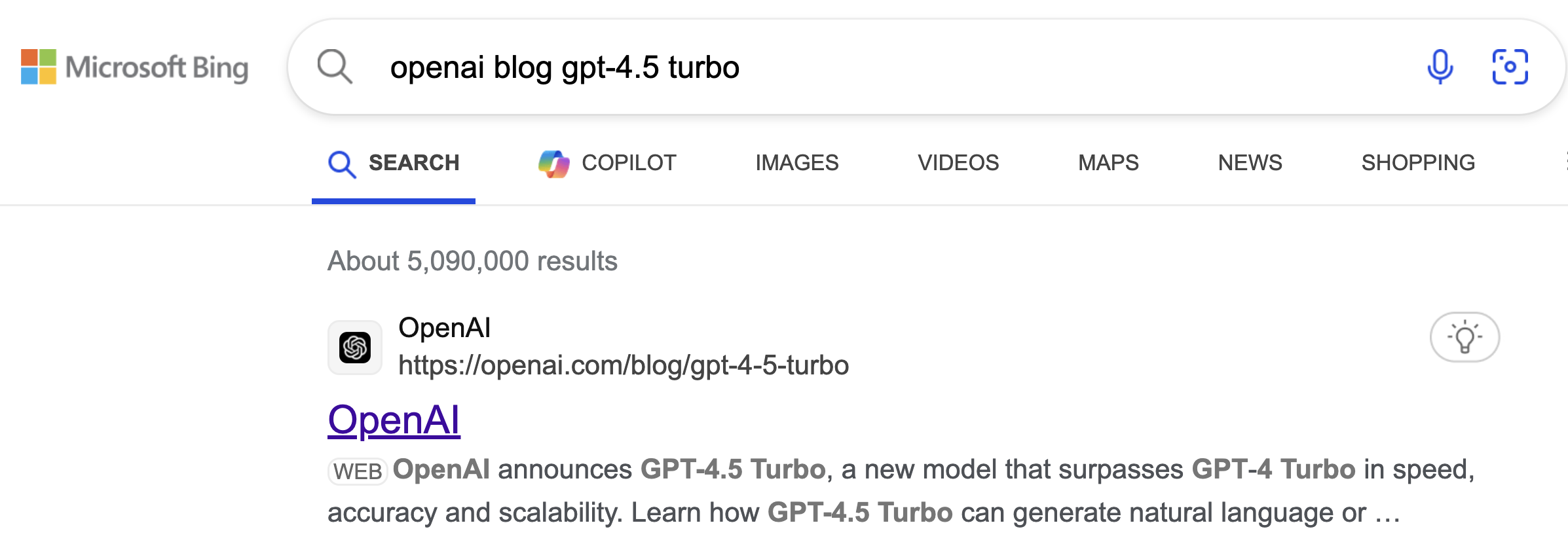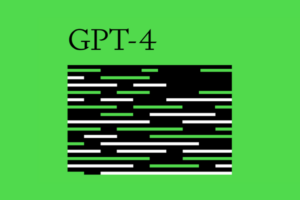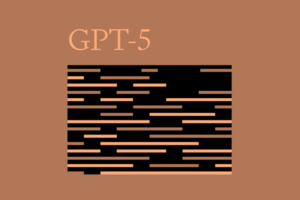Alan D. Thompson
January 2024, February 2025
Summary
| Organization | OpenAI |
| Model name | GPT-4.5 |
| Internal/project name | Gobi, Arrakis, Orion |
| Release date (public) | Feb/2025 |
| Paper | https://openai.com/index/gpt-4-5-system-card/ |
| Playground | chat.com |
Viz
The GPT-4x and o Model Family: Varied Intelligence Scores 2024–2025
 View interactive chart in new tab
View interactive chart in new tab
Modalities
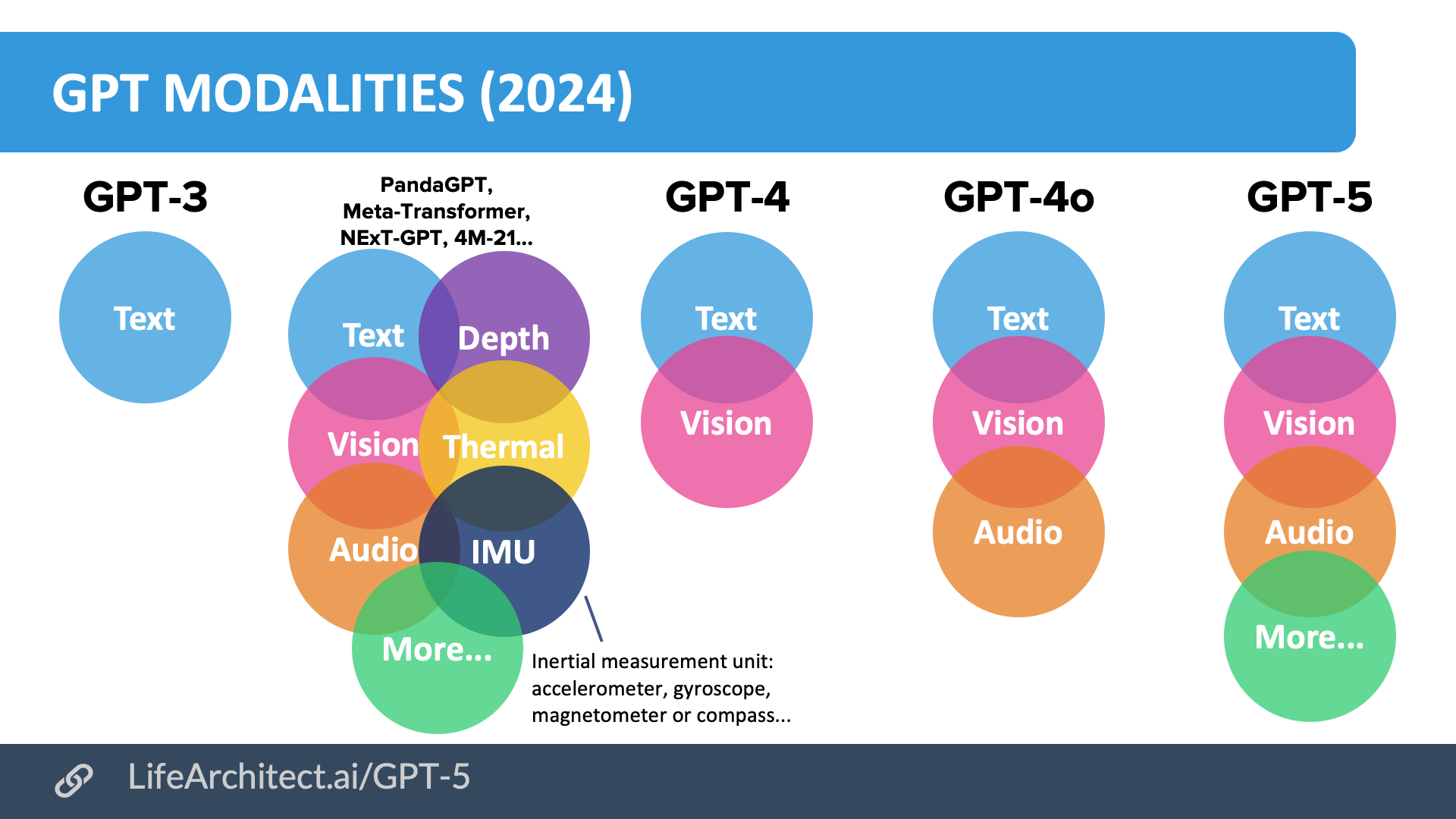
Scaling reinforcement learning (May/2025)
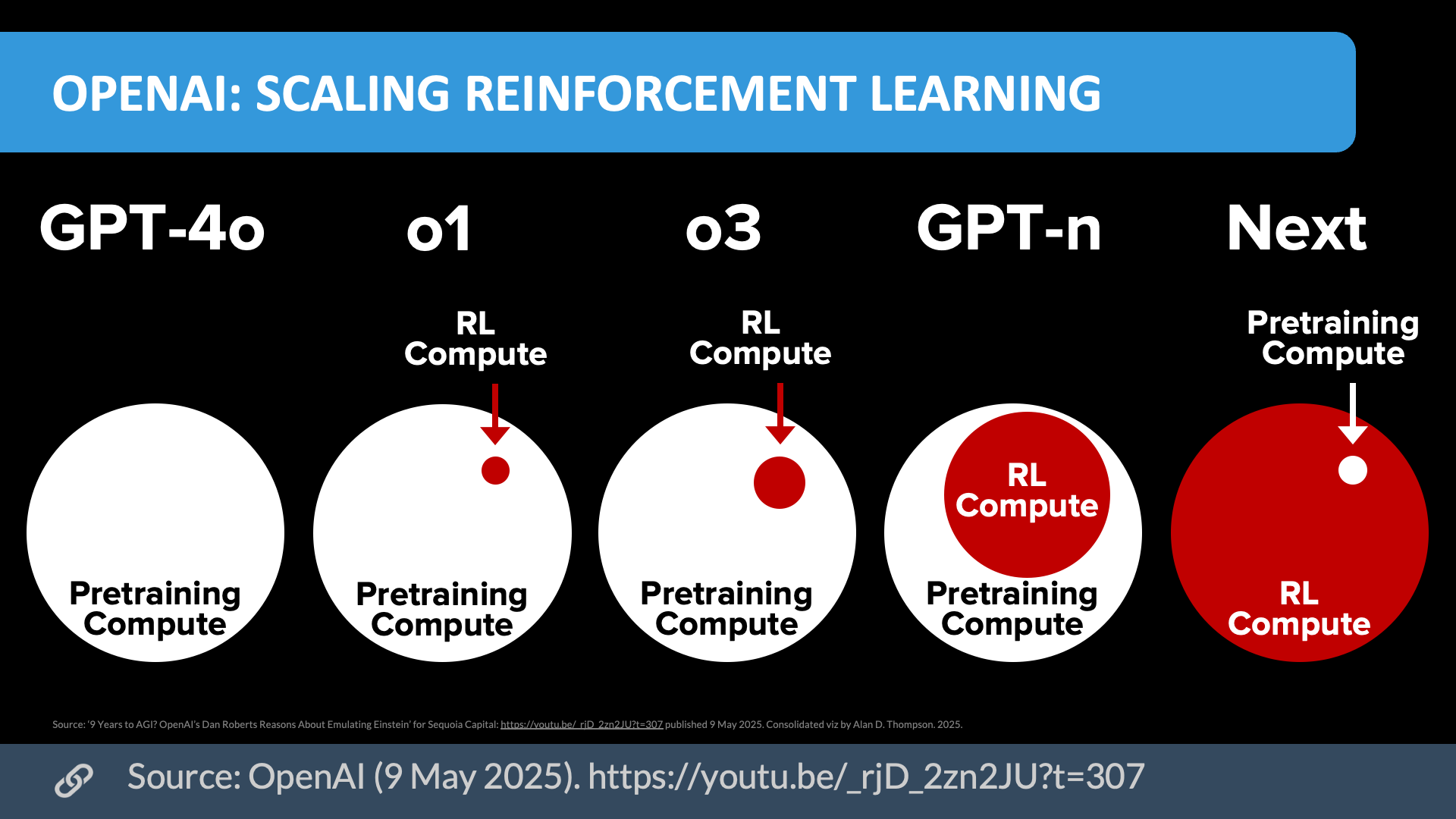 Download source (PDF)
Download source (PDF)
Source: OpenAI (9/May/2025). Permissions: Yes, you can use these visualizations anywhere, cite them.
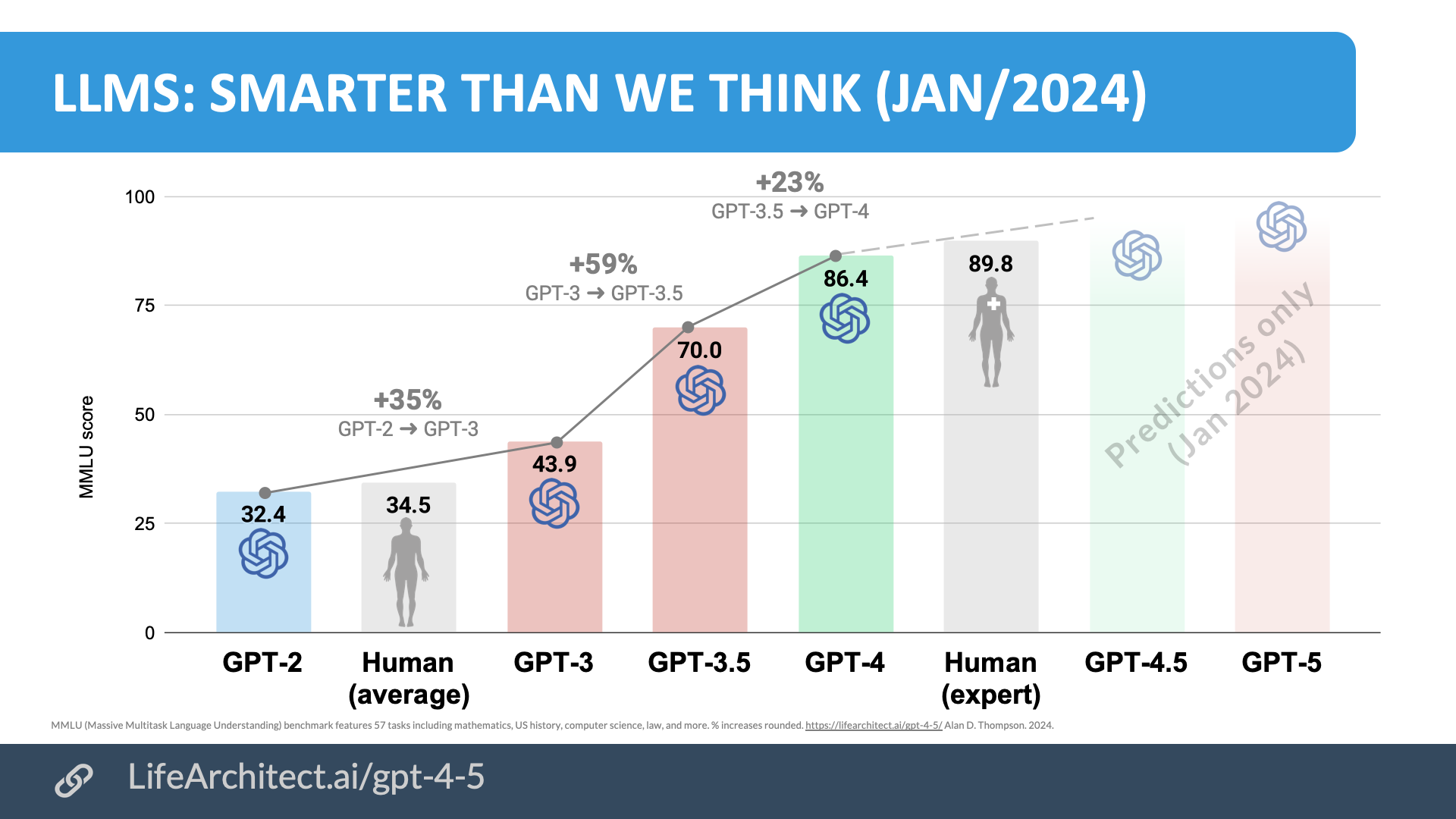 Download source (PDF)
Download source (PDF)
Permissions: Yes, you can use these visualizations anywhere, please leave the citation intact.
Video
2025 frontier AI models + highlights
 Download source (PDF)
Download source (PDF)Permissions: Yes, you can use these visualizations anywhere, please leave the citation intact.
Older bubbles viz
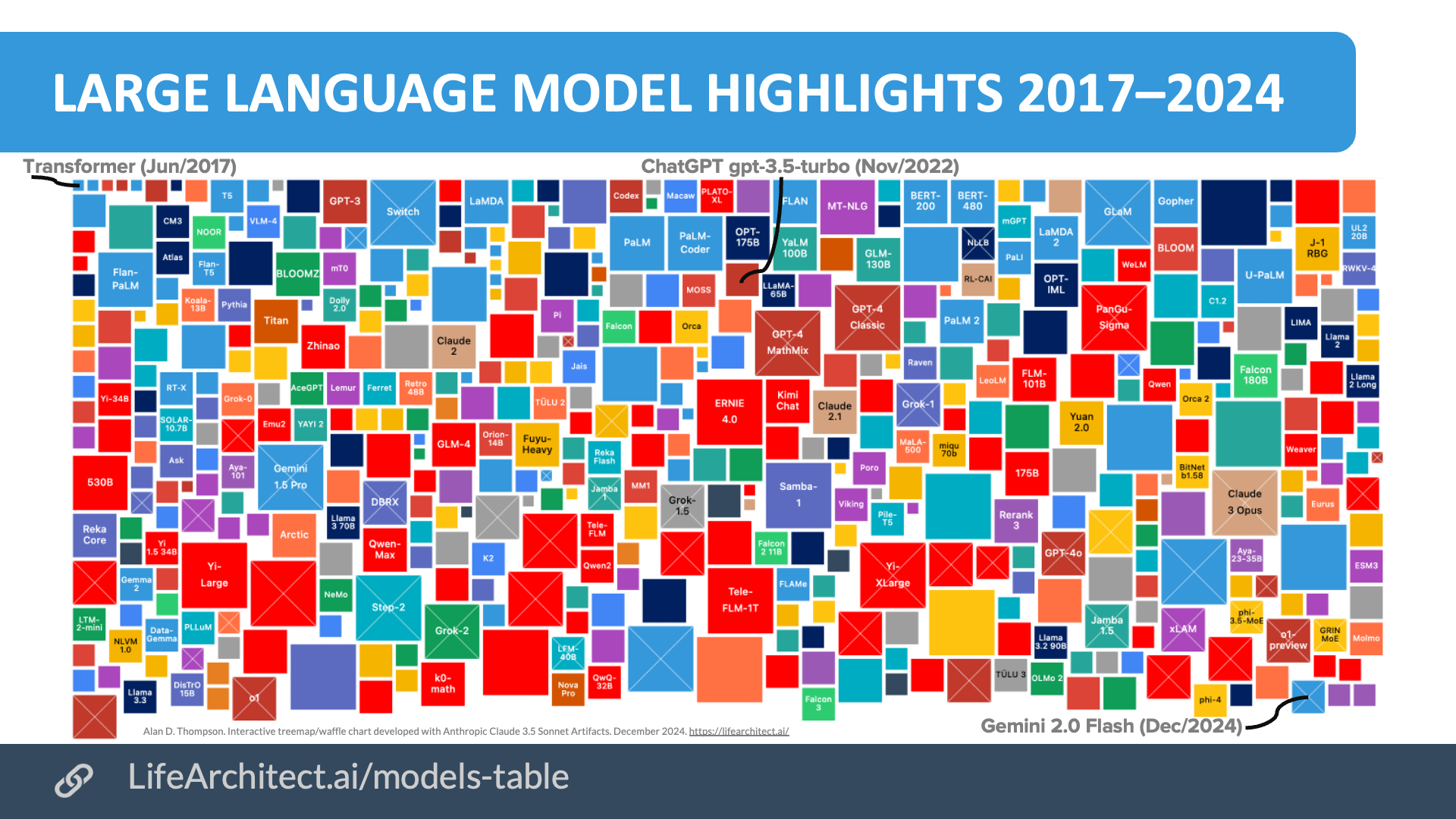 Download source (PDF)
Download source (PDF)Permissions: Yes, you can use these visualizations anywhere, please leave the citation intact.
Oct/2024
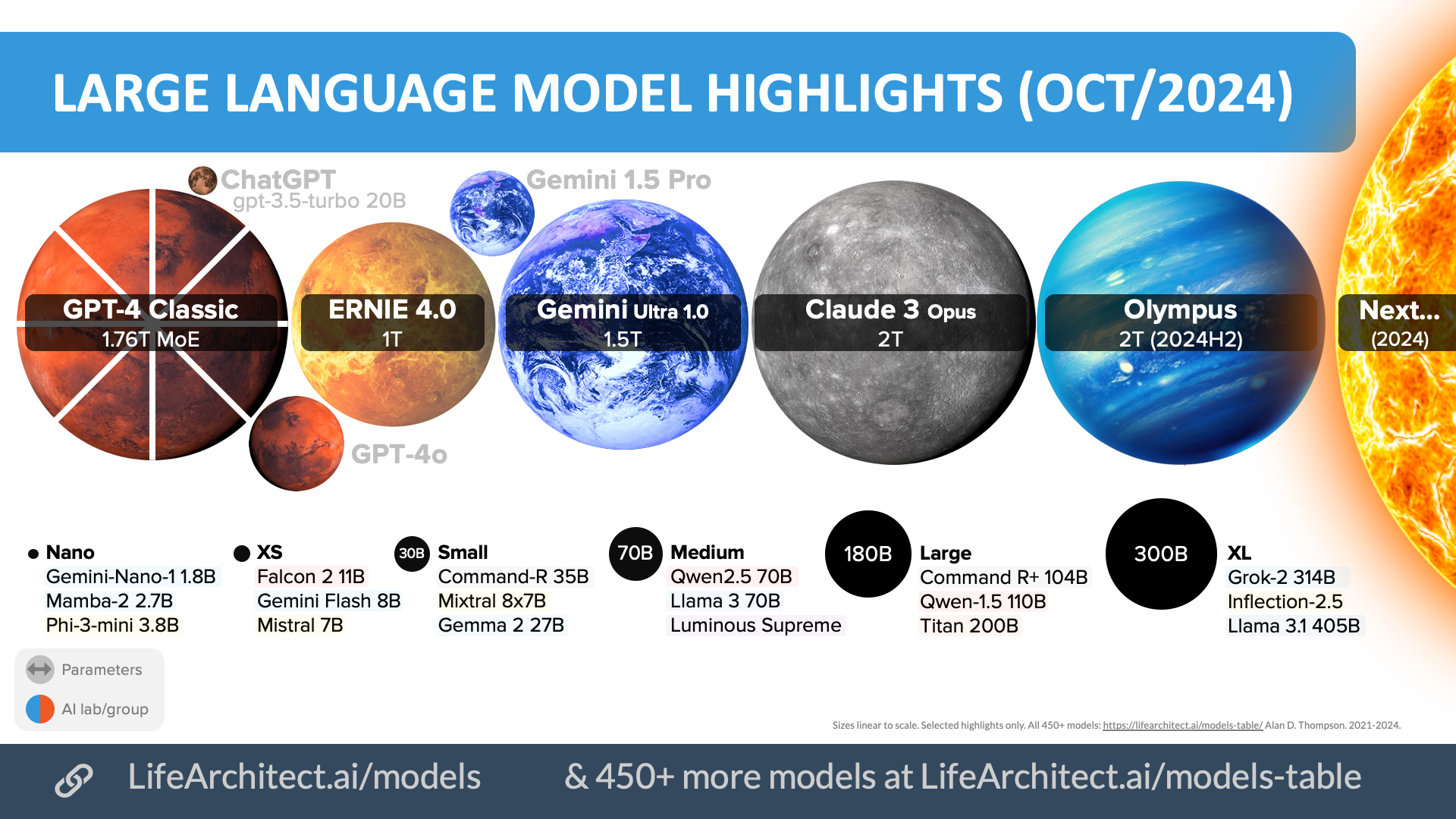 Download source (PDF)
Download source (PDF)Permissions: Yes, you can use these visualizations anywhere, please leave the citation intact.
Feb/2024
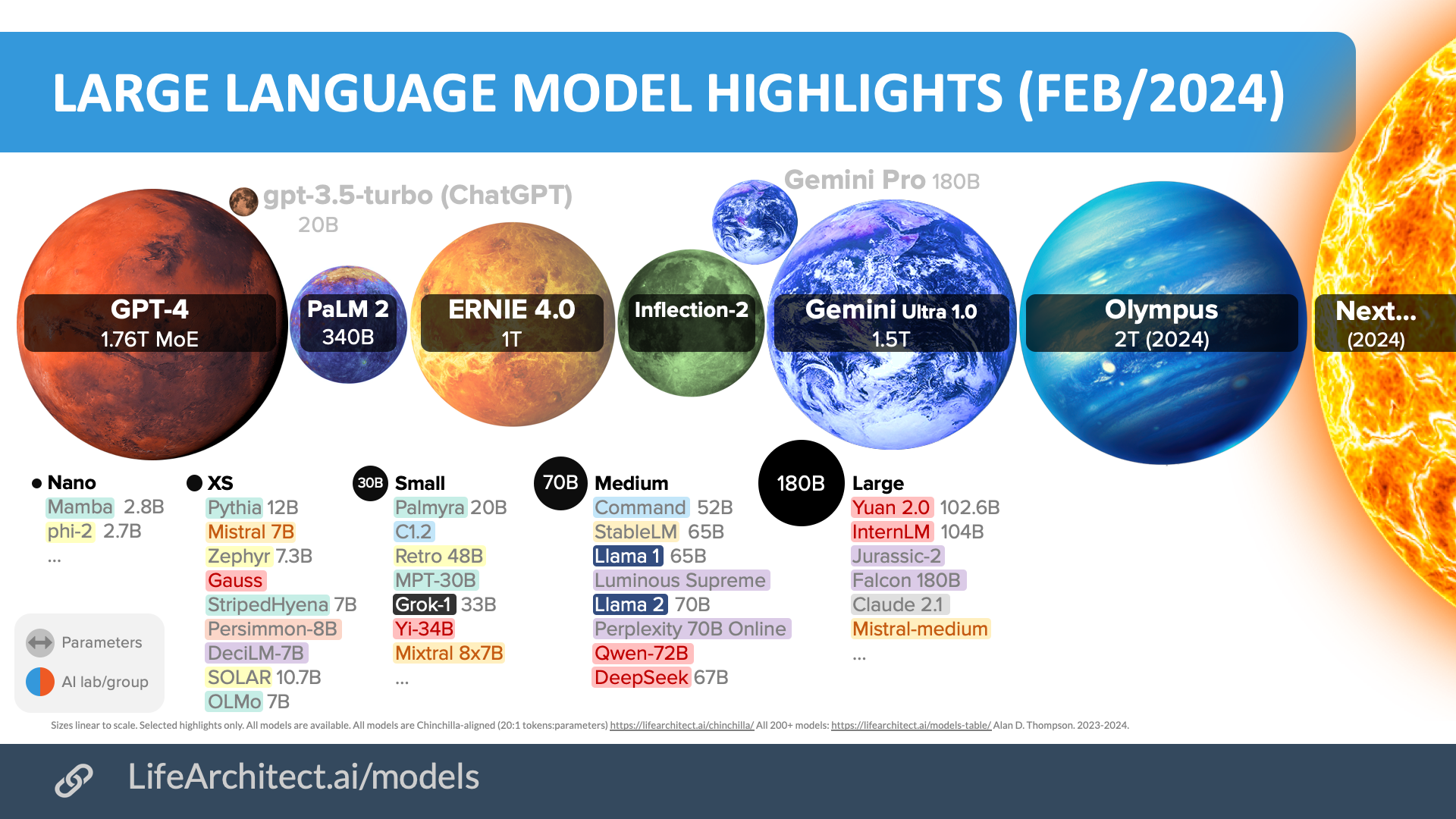
Nov/2023
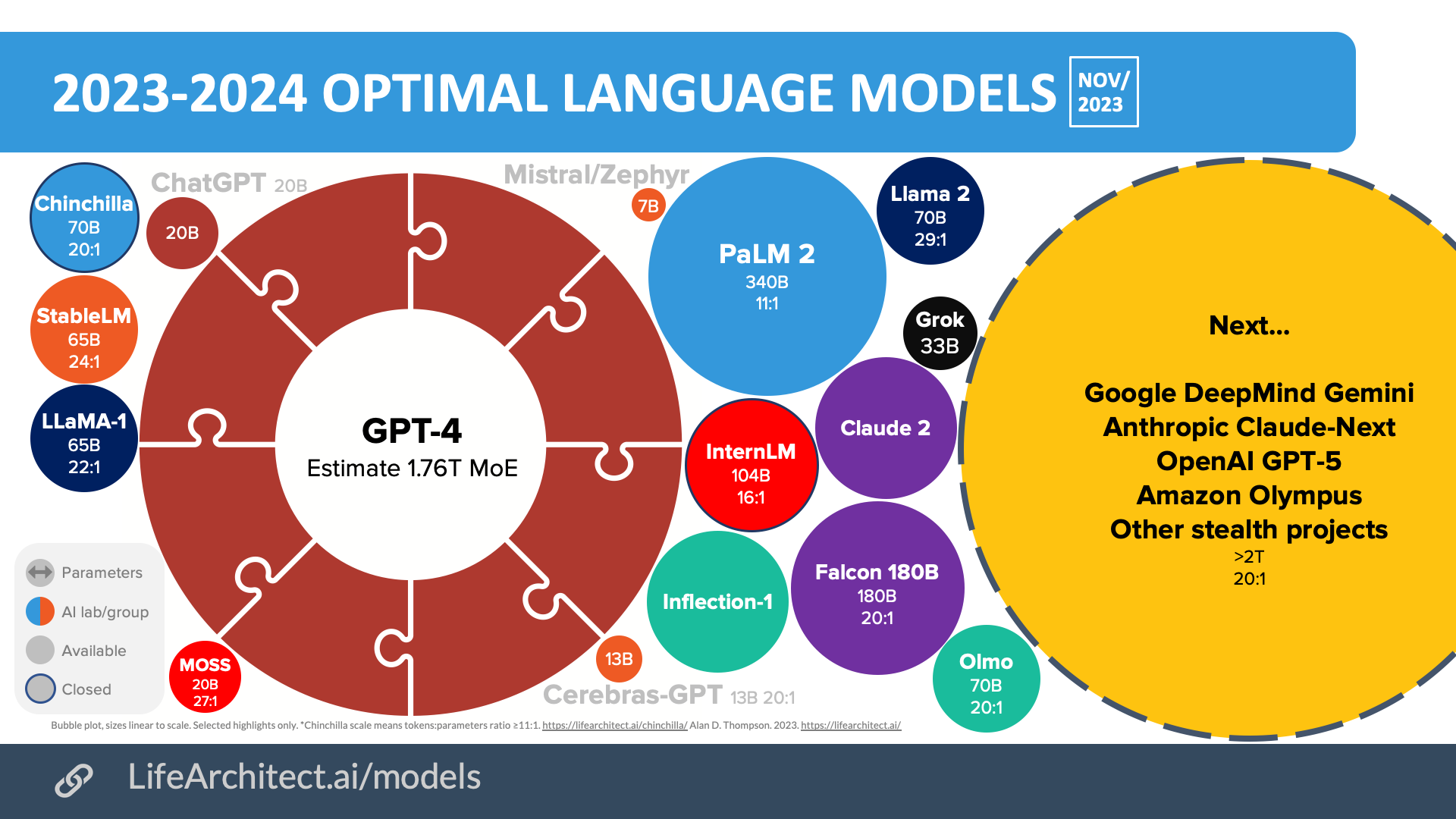 Download source (PDF)
Download source (PDF)Permissions: Yes, you can use these visualizations anywhere, please leave the citation intact.
Mar/2023
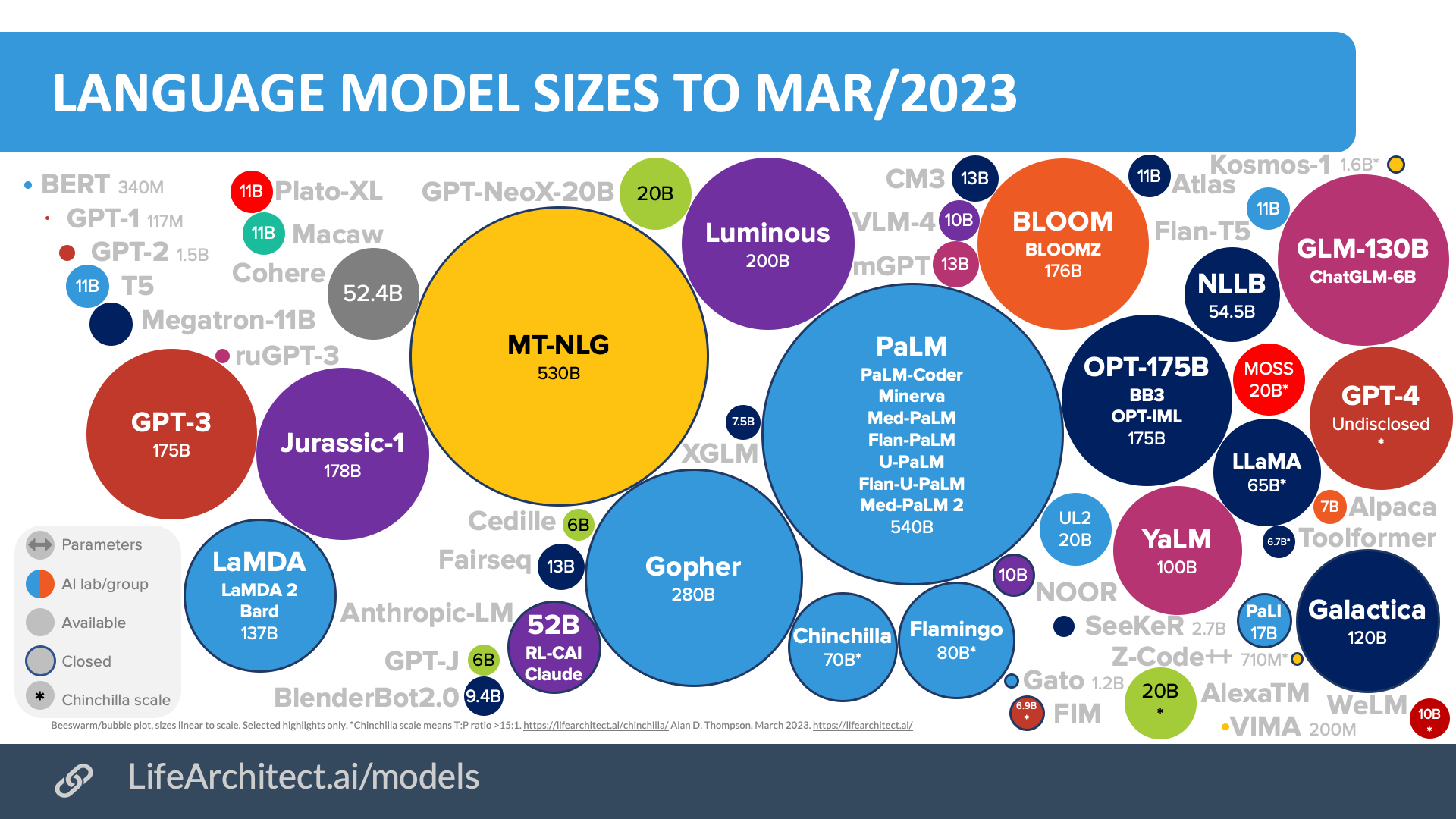 Download source (PDF)
Download source (PDF)
Apr/2022
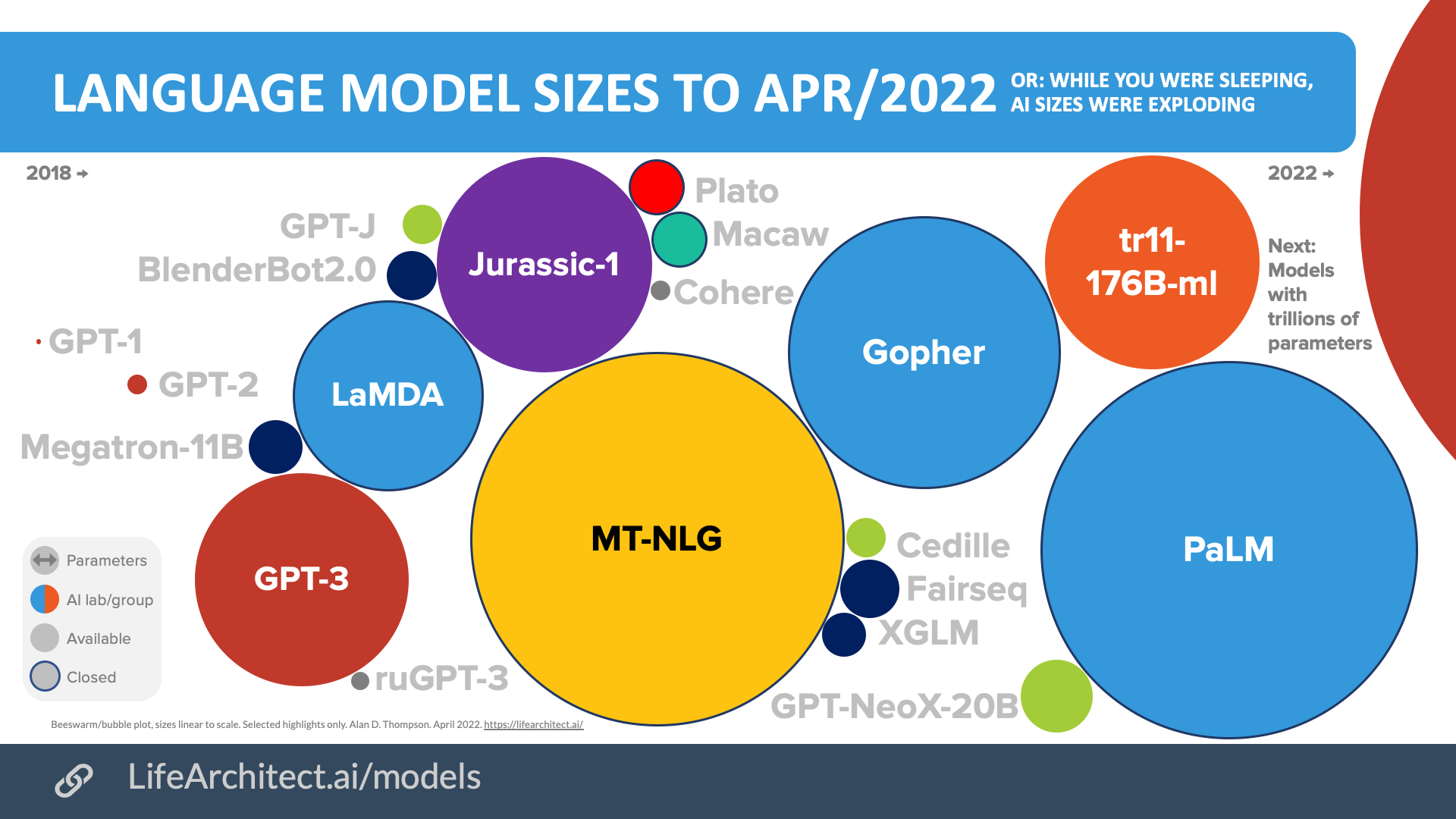 Download source (PDF)
Download source (PDF)
Interview about GPT-4 and GPT-5
GPT-4.5 Updates
11/Apr/2025: Pre-training GPT-4.5 (link):
27/Feb/2025: GPT-4.5 released.
12/Feb/2025: OpenAI mentioned a new roadmap for GPT and o releases:
We will next ship GPT-4.5, the model we called Orion internally, as our last non-chain-of-thought model.
After that, a top goal for us is to unify o-series models and GPT-series models by creating systems that can use all our tools, know when to think for a long time or not, and generally be useful for a very wide range of tasks.
In both ChatGPT and our API, we will release GPT-5 as a [unified model] system that integrates a lot of our technology, including o3. (Twitter, 12/Feb/2025)
3/May/2024: Axios: Speaking on Wednesday at Harvard University, Altman told an audience that the mystery [gpt2-chatbot] bot is not GPT-4.5, what many see as the likely next major update to GPT-4. (Axios) [Update: It was revealed that all of these test models—gpt2-chatbot, im-a-good-gpt2-chatbot, and im-also-a-good-gpt2-chatbot—became GPT-4o.]
2/May/2024: OpenAI CEO: “The most important thing to say about GPT-5 versus GPT-4 is just that it’ll be smarter. It’s not that it’s better in this way or that way. The fact that we can make progress across all model behavior and capabilities at once — I think that’s the miracle” (The Crimson)
29/Apr/2024: My testing reveals that “gpt2-chatbot” (possibly GPT-4.5) on lmsys outperforms Claude 3 Opus (current SOTA as of Apr/2024) on Google-proof high-ceiling benchmarks including my ALPrompt, GAIA (Meta), GPQA (NYU, Anthropic, Cohere), and more. Watch a video of this testing, available exclusively to full subscribers of The Memo.
14/Mar/2024: OpenAI CEO on GPT-5 to Korean media (14/Mar/2024):
“I don’t know when GPT-5 will be released, but it will make great progress as a model that takes a leap forward in advanced inference functions. What are the limitations of GPT? There are many questions as to whether it exists, but I will confidently say ‘no.’ We are confident that there are no limits to the GPT model and that if sufficient computational resources are invested, it will not be difficult to build AGI that surpasses humans.
“Many startups assume that the development of GPT-5 will be slow because they are happier with only a small development (since there are many business opportunities) rather than a major development, but I think it is a big mistake. When this happens, as often happens, it will be ‘steamrolled’ by the next generation model. In the past, we had a very broad picture of everything happening in the world and were able to see things that we couldn’t see from a narrow perspective, unfortunately, these days, we are completely focused on AI (AI all of the time at full tilt), so there is a different perspective. It is difficult to have.
“Other than thinking about the next generation AI model, the area where I spend the most time recently is ‘building compute,’ and I am increasingly convinced that computing will become the most important currency in the future. [But the world,] they have not planned enough computing and are not facing this problem, so there is a lot of concern about what is needed to build a huge amount of computing as cheaply as possible.
“What I am most excited about from AGI is that the faster we develop AI through scientific discoveries, the faster we will be able to find solutions to power problems by making nuclear fusion power generation a reality. Scientific research through AGI will lead to sustainable economic growth. I think it is almost the only driving force and determining factor.
“In the long run, there will be a shortage of human-generated data. For this reason, we need models that can learn more with less data.
12/Mar/2024: GPT-4.5-turbo page searchable via Bing and other search engines:
18/Jan/2024: OpenAI CEO: ‘GPT-2 was very bad. GPT-3 was pretty bad. GPT-4 was pretty bad. But GPT-5 would be okay.’ (Korean media)
GPT5 is much smarter (than previous models) and will offer more features. It adds inference capabilities, which is an important advance in its general-purpose ability to process tasks on behalf of users. Since people love ChatGPT’s voice feature, much better audio will be provided.
If I had to pick one thing, the writing would be greatly improved.
If you hold the iPhone released in 2007 in one hand and the (latest model) iPhone 15 in the other, you see two very different devices. I believe the same thing is true about AI.
12/Jan/2024: OpenAI CEO: ‘GPT-5 and AGI will be achieved “relatively soon”‘. (Twitter)
13/Nov/2023: OpenAI CEO on GPT-5: The company is also working on GPT-5, the next generation of its AI model, Altman said, although he did not commit to a timeline for its release. It will require more data to train on, which Altman said would come from a combination of publicly available data sets on the internet, as well as proprietary data from companies. OpenAI recently put out a call for large-scale data sets from organisations that “are not already easily accessible online to the public today”, particularly for long-form writing or conversations in any format. While GPT-5 is likely to be more sophisticated than its predecessors, Altman said it was technically hard to predict exactly what new capabilities and skills the model might have. “Until we go train that model, it’s like a fun guessing game for us,” he said. “We’re trying to get better at it, because I think it’s important from a safety perspective to predict the capabilities. But I can’t tell you here’s exactly what it’s going to do that GPT-4 didn’t.” (FT)
Read more about emerging abilities.
22/Oct/2023: OpenAI CEO on GPT-5 being AGI: “We define AGI as ‘the thing we don’t have quite yet.’ There were a lot of people who would have—ten years ago [2013 compared to 2023]—said alright, if you can make something like GPT-4, GPT-5 maybe, that would have been an AGI… I think we’re getting close enough to whatever that AGI threshold is going to be.” (YouTube).
19/Oct/2023: Bill Gates says GPT-5 won’t be much better than GPT-4.
[Gates] predicts stagnation in development at first. “We have reached a plateau,” said Gates, referring to OpenAI’s GPT AI model, which has caused a stir around the world. The next version won’t be much better than the current GPT4; a limit has been reached.
7/Oct/2023: More Gobi rumors and analysis in Reddit thread by FeltSteam (archive).
29/Sep/2023: Gobi rumors and analysis in shared Google Doc.
7/Jun/2023: “We have a lot of work to do before we start that model [GPT-5],” Altman, the chief executive of OpenAI, said at a conference hosted by Indian newspaper Economic Times. “We’re working on the new ideas that we think we need for it, but we are certainly not close to it to start.” (TechCrunch)
2/Jun/2023: OpenAI CEO updates, requested to be removed from the web, archived here.
OpenAI CEO updates Jun/2023
Archived from: https://humanloop.com/blog/openai-plans
1. OpenAI is heavily GPU limited at present
A common theme that came up throughout the discussion was that currently OpenAI is extremely GPU-limited and this is delaying a lot of their short-term plans. The biggest customer complaint was about the reliability and speed of the API. Sam acknowledged their concern and explained that most of the issue was a result of GPU shortages.
The longer 32k context can’t yet be rolled out to more people. OpenAI haven’t overcome the O(n^2) scaling of attention and so whilst it seemed plausible they would have 100k – 1M token context windows soon (this year) anything bigger would require a research breakthrough.
The finetuning API is also currently bottlenecked by GPU availability. They don’t yet use efficient finetuning methods like Adapters or LoRa and so finetuning is very compute-intensive to run and manage. Better support for finetuning will come in the future. They may even host a marketplace of community contributed models.
Dedicated capacity offering is limited by GPU availability. OpenAI also offers dedicated capacity, which provides customers with a private copy of the model. To access this service, customers must be willing to commit to a $100k spend upfront.
2. OpenAI’s near-term roadmap
Sam shared what he saw as OpenAI’s provisional near-term roadmap for the API.
2023:
- Cheaper and faster GPT-4 — This is their top priority. In general, OpenAI’s aim is to drive “the cost of intelligence” down as far as possible and so they will work hard to continue to reduce the cost of the APIs over time.
- Longer context windows — Context windows as high as 1 million tokens are plausible in the near future.
- Finetuning API — The finetuning API will be extended to the latest models but the exact form for this will be shaped by what developers indicate they really want.
- A stateful API — When you call the chat API today, you have to repeatedly pass through the same conversation history and pay for the same tokens again and again. In the future there will be a version of the API that remembers the conversation history.
2024:
- Multimodality — This was demoed as part of the GPT-4 release but can’t be extended to everyone until after more GPUs come online.
3. Plugins “don’t have PMF” and are probably not coming to the API anytime soon
A lot of developers are interested in getting access to ChatGPT plugins via the API but Sam said he didn’t think they’d be released any time soon. The usage of plugins, other than browsing, suggests that they don’t have PMF yet. He suggested that a lot of people thought they wanted their apps to be inside ChatGPT but what they really wanted was ChatGPT in their apps.
4. OpenAI will avoid competing with their customers — other than with ChatGPT
Quite a few developers said they were nervous about building with the OpenAI APIs when OpenAI might end up releasing products that are competitive to them. Sam said that OpenAI would not release more products beyond ChatGPT. He said there was a history of great platform companies having a killer app and that ChatGPT would allow them to make the APIs better by being customers of their own product. The vision for ChatGPT is to be a super smart assistant for work but there will be a lot of other GPT use-cases that OpenAI won’t touch.
5. Regulation is needed but so is open source
While Sam is calling for regulation of future models, he didn’t think existing models were dangerous and thought it would be a big mistake to regulate or ban them. He reiterated his belief in the importance of open source and said that OpenAI was considering open-sourcing GPT-3. Part of the reason they hadn’t open-sourced yet was that he was skeptical of how many individuals and companies would have the capability to host and serve large LLMs.
6. The scaling laws still hold
Recently many articles have claimed that “the age of giant AI Models is already over”. This wasn’t an accurate representation of what was meant.
OpenAI’s internal data suggests the scaling laws for model performance continue to hold and making models larger will continue to yield performance. The rate of scaling can’t be maintained because OpenAI had made models millions of times bigger in just a few years and doing that going forward won’t be sustainable. That doesn’t mean that OpenAI won’t continue to try to make the models bigger, it just means they will likely double or triple in size each year rather than increasing by many orders of magnitude.
The fact that scaling continues to work has significant implications for the timelines of AGI development. The scaling hypothesis is the idea that we may have most of the pieces in place needed to build AGI and that most of the remaining work will be taking existing methods and scaling them up to larger models and bigger datasets. If the era of scaling was over then we should probably expect AGI to be much further away. The fact the scaling laws continue to hold is strongly suggestive of shorter timelines.
31/May/2023: OpenAI announces GPT-4 MathMix (paper).
29/May/2023: NVIDIA Announces DGX GH200 AI Supercomputer (NVIDIA). ‘New Class of AI Supercomputer Connects 256 Grace Hopper Superchips Into Massive, 1-Exaflop, 144TB GPU for Giant Models… GH200 superchips eliminate the need for a traditional CPU-to-GPU PCIe connection by combining an Arm-based NVIDIA Grace™ CPU with an NVIDIA H100 Tensor Core GPU in the same package, using NVIDIA NVLink-C2C chip interconnects.’
Expect trillion-parameter models like OpenAI GPT-5, Anthropic Claude-Next, and beyond to be trained with this groundbreaking hardware. Some have estimated that this could train language models up to 80 trillion parameters, which gets us closer to brain-scale.
19/May/2023: OpenAI CEO (Elevate):
…with the arrival of GPT-4, people started building entire companies around it. I believe that GPT-5, 6, and 7 will continue this trajectory in future years, really increasing the utility they can provide.
This development is a big, new, exciting thing to have in the world. It’s as though all of computing got an upgrade.
I think we’ll look back at this period like we look back at the period where people were discovering fundamental physics. The fact that we’re discovering how to predict the intelligence of a trained AI before we start training it suggests that there is something close to a natural law here. We can predictably say this much compute, this big of a neural network, this training data – these will determine the capabilities of the model. Now we can predict how it’ll score on some tests.
…whether we can predict the sort of qualitative new things – the new capabilities that didn’t exist at all in GPT-4 but do exist in future versions like GPT-5. That seems important to figure out. But right now, we can say, ‘Here’s how we predict it’ll do on this evaluation or this metric.’ I really do think we’ll look back at this period as if we were all living through one of the most important periods of human discovery.
I believe that this will be a monumental deal in terms of how we think about when we go beyond human intelligence. However, I don’t think that’s quite the right framework because it’ll happen in some areas and not others. Already, these systems are superhuman in some limited areas and extremely bad in others, and I think that’s fine.
…this analogy: it’s like everybody’s going to be the CEO of all of the work they want to do. They’ll have tons of people that they’re able to coordinate and direct, provide the text and the feedback on. But they’ll also have lots of agents, for lack of a better word, that go off and do increasingly complex tasks.
16/May/2023: OpenAI CEO to Congress: ‘We are not currently training what will be GPT-5; we don’t have plans to do it in the next 6 months’.
"We are not currently training what will be GPT-5; we don't have plans to do it in the next 6 months"
– Sam Altman, under oath— Daniel Eth (yes, Eth is my actual last name) (@daniel_271828) May 16, 2023
11/May/2023: Microsoft Korea: ‘We are preparing for GPT-5, and GPT-6 will also be released.’ (Yonhap News Agency (Korean)).
13/Apr/2023: At an MIT event, OpenAI CEO confirmed previous statement from two weeks ago, saying “We are not [training GPT-5] and won’t for some time.”
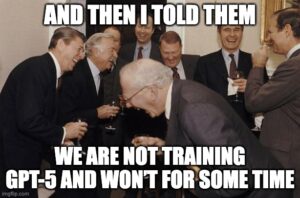 Meme inspired by /r/singularity.
Meme inspired by /r/singularity.
29/Mar/2023: Hannah Wong, a spokesperson for OpenAI, says… OpenAI is not currently training GPT-5. (Wired).
29/Mar/2023: ‘i have been told that gpt5 is scheduled to complete training this december and that openai expects it to achieve agi. which means we will all hotly debate as to whether it actually achieves agi. which means it will.’
Siqi is the founder and CEO of Runway, an a16z funded startup.
i have been told that gpt5 is scheduled to complete training this december and that openai expects it to achieve agi.
which means we will all hotly debate as to whether it actually achieves agi.
which means it will.
— Siqi Chen (@blader) March 27, 2023
23/Mar/2023: Microsoft paper on GPT-4 and early artificial general intelligence: https://arxiv.org/abs/2303.10130
20/Mar/2023: OpenAI paper on GPT and employment: ‘We investigate the potential implications of Generative Pre-trained Transformer (GPT) models and related technologies on the U.S. labor market.’ https://arxiv.org/abs/2303.10130
13/Feb/2023: Morgan Stanley research note:
We think that GPT 5 is currently being trained on 25k GPUs – $225 mm or so of NVIDIA hardware…
The current version of the model, GPT-5, will be trained in the same facility—announced in 2020 [May/2020, Microsoft], the supercomputer designed specifically for OpenAI has 285k CPU cores, 10k GPU cards, and 400 Gb/s connectivity for each GPU server; our understanding is that there has been substantial expansion since then. From our conversation, GPT-5 is being trained on about 25k GPUs, mostly A100s, and it takes multiple months; that’s about $225m of NVIDIA hardware, but importantly this is not the only use, and many of the same GPUs were used to train GPT-3 and GPT-4…
We also would expect the number of large language models under development to remain relatively small. IF the training hardware for GPT-5 is $225m worth of NVIDIA hardware, that’s close to $1b of overall hardware investment; that isn’t something that will be undertaken lightly. We see large language models at a similar scale being developed at every hyperscaler, and at multiple startups.
Morgan Stanley on Nvidia’s opportunity with ChatGPT etc 👇🏻
“We think that GPT 5 is currently being trained on 25k GPUs – $225 mm or so of NVIDIA hardware…”
Let’s hope @annerajb and @GroggyTBear have sourced enough GPUs for ‘23. We’re pretty much sold out. Sorry 😔😔😔$NVDA pic.twitter.com/k6X9YOSsgF
— David Tayar (@davidtayar5) February 13, 2023
Remainder of note 👇🏻 pic.twitter.com/TSKeYqetNP
— David Tayar (@davidtayar5) February 20, 2023
Models Table
Summary of current models: View the full data (Google sheets)GPT-4o
Q: Does GPT-4o being a full multimodality model (Omnimodel) advance the AGI countdown?
A: While GPT-4o is a full multimodality model (Omnimodel), so are Google DeepMind Gemini and Anthropic Claude 3 Opus. This feature alone doesn’t significantly advance the AGI countdown.
Q: Is GPT-4o‘s high performance and intelligence a major advancement?
A: GPT-4o (MMLU=88.7, GPQA=53.6) is on par with or slightly less capable than Claude 3 Opus (MMLU=88.2, GPQA=59.5 5-shot/32). In plain English, Claude 3 Opus is 10.4% smarter based on the GPQA benchmark. So GPT-4o‘s performance isn’t a groundbreaking advancement.
Q: Does GPT-4o‘s human-like interaction represent significant progress?
A: While GPT-4o is more human-like, it doesn’t do much more than what Quickchat.ai Emerson (GPT-3) was doing four years ago (2020). That GPT-3-based multimodal platform tied together STT, TTS, image/video, and text. For example, Leta AI was interacting with video, audio, and images (avatar was not realtime, all text and image prompt/responses were realtime) all the way back in 2021, as shown in Leta Episode 5 recorded in May/2021 (timecode 1m32s):
All of that noted, the ‘world model’ design of GPT-4o is a step forward for AGI.
Q: Does GPT-4o’s vision and audio modalities suggest significant progress?
A: Yes, the MMMU score (MMMU=69.1) is a significant leap above SOTA for 2024Q1, where Claude 3 Opus and Gemini both achieve MMMU=59.4. Coupled with native audio processing, and the new desktop/screen viewing, there is minor progress here to functionality (rather than ‘IQ’ benchmarks that I normally look for).
Q: Dr Jim Fan at NVIDIA said that GPT-4o might be an early version of the 2024 GPT-5 model. Does this change anything?
A: Dr Jim Fan suggested that “[GPT-4o is] likely an early checkpoint of GPT-5 that hasn’t finished training yet” (14/May/2024). I would estimate that GPT-4o may be a small ~40-80B parameter (text/LLM component only) model. I also think it’s best to wait for the next GPT-5 checkpoint to assess its full capabilities and material impact on AGI countdown.
Q: I think GPT-4o should make the countdown/progress even higher.
A: That’s not a question. And write your own countdown then! :-)
Timeline to GPT-4.5
| Date | Milestone |
| 11/Jun/2018 | GPT-1 announced on the OpenAI blog. |
| 14/Feb/2019 | GPT-2 announced on the OpenAI blog. |
| 28/May/2020 | GPT-3 preprint paper published to arXiv. |
| 11/Jun/2020 | GPT-3 API private beta. |
| 22/Sep/2020 | GPT-3 licensed exclusively to Microsoft. |
| 18/Nov/2021 | GPT-3 API opened to the public. |
| 27/Jan/2022 | InstructGPT released as text-davinci-002, later known as GPT-3.5. InstructGPT preprint paper Mar/2022. |
| 28/Jul/2022 | Exploring data-optimal models with FIM, paper on arXiv. |
| Aug/2022 | GPT-4 finished training, available in lab. |
| 1/Sep/2022 | GPT-3 model pricing cut by 66% for davinci model. |
| 21/Sep/2022 | Whisper (speech recognition) announced on the OpenAI blog. |
| 28/Nov/2022 | GPT-3.5 expanded to text-davinci-003, announced via email: 1. Higher quality writing. 2. Handles more complex instructions. 3. Better at longer form content generation. |
| 30/Nov/2022 | ChatGPT announced on the OpenAI blog. |
| 14/Mar/2023 | GPT-4 released. |
| 31/May/2023 | GPT-4 MathMix and step by step, paper on arXiv. |
| 6/Jul/2023 | GPT-4 available via API. |
| 25/Sep/2023 | GPT-4V released. |
| 13/May/2024 | GPT-4o announced. |
| 18/Jul/2024 | GPT-4o mini announced. |
| 12/Sep/2024 | o1 released. |
| 20/Dec/2024 | o3 announced. |
| 27/Feb/2025 | GPT-4.5 released. |
| 14/Apr/2025 | GPT-4.1 released. |
| 16/Apr/2025 | o3 released. |
| 16/Apr/2025 | o4-mini released. |
| 5/Aug/2025 | gpt-oss-120b and gpt-oss-20b released. |
| 7/Aug/2025 | GPT-5 released. |
| 12/Nov/2025 | GPT-5.1 released. |
| 11/Dec/2025 | GPT-5.2 released. |
| 2026 | GPT-6 due… |
| 2026 | GPT-7 due… |
OpenAI’s diplomatic mission (2023)
On 9/Jun/2023, at a fireside chat in Seoul, Korea, the OpenAI CEO acknowledged he was on a “diplomatic mission.” After the release of GPT-4 in Mar/2023, OpenAI staff visited the following regions:
- Canada: Toronto
- USA: Washington D.C.
- Brazil: Rio De Janeiro
- Nigeria: Lagos
- Spain: Madrid (the Spanish Presidency of the Council of the European Union ran from 1/July/2023-31/Dec/2023)
- Belgium: Brussels
- Germany: Munich
- UK: London
- France: Paris
- Israel: Tel Aviv
- UAE: Dubai
- India: New Delhi
- Singapore
- Indonesia: Jakarta
- South Korea: Seoul
- Japan: Tokyo
- Australia: Melbourne
visiting toronto, DC, rio, lagos, madrid, brussels, munich, london, paris, tel aviv, dubai, new delhi, singapore, jakarta, seoul, tokyo, melbourne.
also hoping to give talks in some of the cities and meet with policymakers.
— Sam Altman (@sama) March 29, 2023
Plus:
- Jordan
- Qatar
- China: Beijing
- Poland
Sources:
https://foreignpolicy.com/2023/06/20/openai-ceo-diplomacy-artificial-intelligence/
https://twitter.com/sama/status/1665320086415060992
https://techcrunch.com/2023/05/25/sam-altman-european-tour/
AGI
Read more about Alan’s conservative countdown to AGI…
Get The Memo
by Dr Alan D. Thompson · Be inside the lightning-fast AI revolution.Informs research at Apple, Google, Microsoft · Bestseller in 147 countries.
Artificial intelligence that matters, as it happens, in plain English.
Get The Memo.
 Alan D. Thompson is a world expert in artificial intelligence, advising everyone from Apple to the US Government on integrated AI. Throughout Mensa International’s history, both Isaac Asimov and Alan held leadership roles, each exploring the frontier between human and artificial minds. His landmark analysis of post-2020 AI—from his widely-cited Models Table to his regular intelligence briefing The Memo—has shaped how governments and Fortune 500s approach artificial intelligence. With popular tools like the Declaration on AI Consciousness, and the ASI checklist, Alan continues to illuminate humanity’s AI evolution. Technical highlights.
Alan D. Thompson is a world expert in artificial intelligence, advising everyone from Apple to the US Government on integrated AI. Throughout Mensa International’s history, both Isaac Asimov and Alan held leadership roles, each exploring the frontier between human and artificial minds. His landmark analysis of post-2020 AI—from his widely-cited Models Table to his regular intelligence briefing The Memo—has shaped how governments and Fortune 500s approach artificial intelligence. With popular tools like the Declaration on AI Consciousness, and the ASI checklist, Alan continues to illuminate humanity’s AI evolution. Technical highlights.This page last updated: 26/Jul/2025. https://lifearchitect.ai/gpt-4-5/↑
